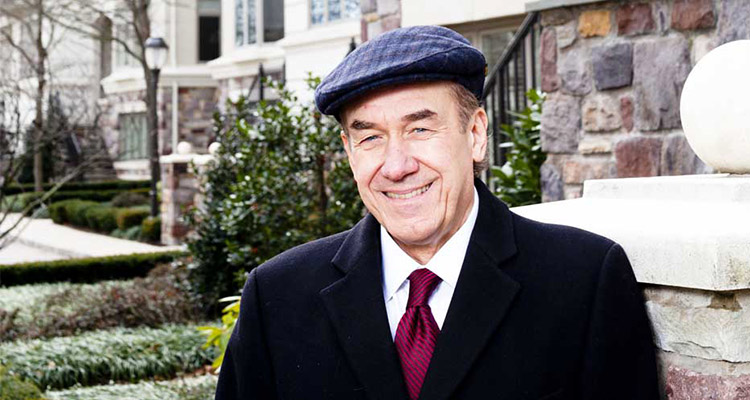
Tom Scannapieco

THE LAST WORD
Not even the recession fazed the New Hope developer’s meteoric trajectory over the last decade. And with his two latest projects well underway, one in the city and the other in the ‘burbs, he’s showing no signs of flaming out any time soon.
By Scott Edwards

A rendering of Rabbit Run Creek. Top: Scannapieco, pictured outside of Waterview, another one of his New Hope projects. Below: 500 Walnut.
Tom Scannapieco is sitting around a conference room table with the Buckingham metalsmith Ray Mathis talking through Mathis’ sketches of the gates for Rabbit Run Creek, the high-end townhome community Scannapieco’s building across town. Toll Brothers, this is not. Thirty-seven homes, each about 3,500 square feet, each with its own elevator, will be embedded among pocket parks. The asking prices start at just over a million.
Rabbit Run Creek is Scannapieco’s suburban follow-up to Waterview, which changed the game for the New Hope developer. “That was a real departure because no one ever built million-dollar condominiums in the suburbs,” he says. Again, not what you’re thinking. Twenty-eight nearly-4,000-square foot condos perched right on the west bank of the Delaware, a short walk from downtown New Hope. Every one of them sold before construction was even completed in 2006.
Scannapieco used roughly the same template in erecting the 31-story 1706 Rittenhouse Square, which was named among the Urban Land Institute’s “Top 20 Projects in the Americas” in 2011. He wanted to build it on the Main Line and in Princeton, New Jersey, but land and progress came faster in Philadelphia. Construction ebbed through the recession, but Scannapieco never lowered his asking prices. Again, every condo sold ahead of schedule. And three have since been sold again—for at least a million over the original asking price in a mere three years.
 Last April, Scannapieco found himself publicly refuting a rumor that Jay-Z and Bey had bought the penthouse at 500 Walnut, another posh, 26-story condo tower shooting up over Society Hill, overlooking Independence Hall. “The rumor was that they bought it for $20 million, which was curious because we only had it on the market for 17.6,” he says, a sly grin underlining the obvious: Not exactly bad publicity. Nonetheless, he’s still looking for a taker. Precedent says he won’t be for much longer.
Last April, Scannapieco found himself publicly refuting a rumor that Jay-Z and Bey had bought the penthouse at 500 Walnut, another posh, 26-story condo tower shooting up over Society Hill, overlooking Independence Hall. “The rumor was that they bought it for $20 million, which was curious because we only had it on the market for 17.6,” he says, a sly grin underlining the obvious: Not exactly bad publicity. Nonetheless, he’s still looking for a taker. Precedent says he won’t be for much longer.
The real estate mogul may have no regrets about abandoning a career as a physicist, but that doesn’t mean he doesn’t still think like one. Also, for someone who spends most of his days thinking about how the upper crust lives, he’s remarkably low-maintenance.
I bought my first property … in 1974 for $11,000. It was a shell of a post-Civil War townhome in the art museum area. Those houses now are all million-dollar townhouses. I basically took a building that was converted into six small residential units and converted it into three condominiums. Sold two and lived in one. Great memories of that.
If I didn’t become a developer … I’d be an architect, because I love design, or an investment banker, because I enjoy structuring deals and negotiating land.
The last book I read was … Suburban Nation: The Rise of Sprawl and the Decline of the American Dream (North Point Press, 2000), by Elizabeth Plater-Zyberk [and Andres Duany and Jeff Speck]. It was written 16 years ago, but she already perceived what we are now fully recognizing, this movement toward community and more urban-type spaces. And a lot of her comments, I think, were a result of living close to New Hope. As you read the book, you see her talking about New Hope.
The last show I binge-watched was … Probably “24.” Actually, the last one was “House of Cards.” I kind of liked the earlier episodes more than the later episodes. By the end of it, I was done with it.
If I ran Philadelphia … I would take all the empty rowhomes and give them to people. And then I would give them free materials and let them fix them up themselves. Because right now we have a system where you have people that need housing and we think the way to approach that is to pay people $100 an hour to go build a house for them. So you’re addressing one hundredth of one percent of the problem, because that’s all you can afford. You’re spending $200,000 to $300,000 to build a low-income house. Just give them a credit card for Home Depot and limit how much they can buy at any point in time and have spot inspections to make sure the money’s being spent. I think we’d be amazed at what people can do if they’re not told how to do it, they’re not inspected twice a day and they’re just left to do it themselves. And it would be a fraction of the cost of what we’re doing today.
To break a sweat, I … play racquetball once a week and I lift probably three times a week. I go to Cornerstone, here in New Hope.
When I’m not working, I’m … reading the newspaper in a bay window overlooking the river.
My last vacation … was in Venice, a year-and-a-half ago. My daughter was living in London and moving back to Philadelphia, so I met her in Venice and the two of us spent four days there during the Biennale. That was fantastic. It was like going to a world’s fair.
My death-row meal … would be between pizza and a pasta dish with a seafood marinara sauce or something like that. The pizza would probably be plain, nothing imaginative.
The advice that’s stuck most with me … I can’t put a source to it, but I absolutely believe that things are never as bad or as good as you think they are. There’s a real coming back to the norm. It’s just a point in time and, eventually, that’ll pass too.
In five years, … I’d like to be doing exactly what I’m doing. I’ve thought about retirement off and on. It’s only in the last year or so that I finally clarified in my mind that that’s not my calling.
Portrait by Josh DeHonney | Renderings courtesy Scannapieco Development Corp.












